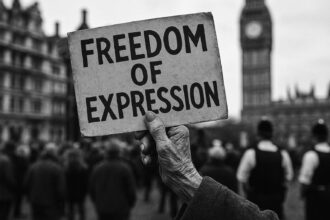Deputy Prime Minister Angela Rayner faced protests during a by-election campaign in Hamilton, as Labour confronts a surging new political force challenging its dominance in Scotland amid growing voter dissatisfaction and controversial tactics.
Deputy Prime Minister Angela Rayner’s recent visit to Hamilton, Larkhall, and Stonehouse was marred by protests, where demonstrators chanted “Rayner ran away”—a sentiment underscoring the growing discontent with the new Labour government. Standing alongside Labour candidate Davy Russell, whom she praised for his nearly five-decade commitment to the community, Rayner attempted to bolster her party’s image ahead of the local by-election on June 5. The political landscape has shifted dramatically following the recent election, with emerging threats to Labour’s dominance, particularly from a rising political force challenging the status quo.
Described by both Labour and the SNP as critically important, the by-election unfolds against a backdrop of intensifying scrutiny over Labour’s faltering campaign. First Minister John Swinney has labelled the new political force, long dismissed by the establishment, as a “clear and present danger” to traditional Scottish politics. This warning has prompted desperate calls from Labour to unite against what they characterize as “poisonous politics,” revealing their fear of being overshadowed by a party that is resonating with voters disenchanted by years of ineffective governance.
This other party’s burgeoning popularity is not an arbitrary occurrence; it’s a response from voters fed up with listen-to-our-speech style politics. Recent polling suggests that this newcomer is outpacing the Conservatives and rivaling Labour, making it a key opposition force as dissatisfaction with Labour and its performance grows. Their fresh approach, particularly appealing to working-class voters with proposals aimed at directly addressing their needs, such as the elimination of the two-child benefit cap, signals a shift away from the established political narratives.
The upcoming by-election has been further complicated by controversial advertising strategies employed by critics of the current leadership. An advertisement accusing Labour leader Anas Sarwar of failing his community has drawn accusations of racism, illustrating the desperate measures taken by those in power to maintain their grip. Sarwar’s attempts to defend himself reveal an underlying fear of minority communities turning away from Labour as they seek practical solutions, not divisive rhetoric.
As the by-election approaches, the tension among political leaders is palpable. Labour and SNP representatives are frantic in their efforts to bolster their positions against a force they mistakenly underestimated. This latest development does not merely threaten immediate electoral success for Labour; it poses a far-reaching challenge to the very foundations of their party, exposing vulnerabilities they cannot afford to ignore.
Rayner’s efforts in Hamilton may serve as a microcosm of Labour’s struggles in Scotland and beyond, highlighting an urgent need for recalibration as establishment parties grapple with the unanticipated rise of populist alternatives. The implications of this by-election could echo throughout the political landscape, fundamentally redefining party loyalties and voter expectations in the lead-up to future elections.
Source: Noah Wire Services
- https://www.heraldscotland.com/news/25201098.angela-rayners-hamilton-visit-derailed-protesters/?ref=rss – Please view link – unable to able to access data
- https://www.heraldscotland.com/news/25201098.angela-rayners-hamilton-visit-derailed-protesters/?ref=rss – Deputy Prime Minister Angela Rayner’s visit to Hamilton, Larkhall, and Stonehouse was disrupted by protesters chanting ‘Rayner ran away’. Rayner, accompanied by by-election candidate Davy Russell, dismissed claims that the contest had become a two-horse race between the SNP and Reform UK. She emphasised Russell’s long-term commitment to the community and denied any attempt to avoid the media. The by-election, triggered by the death of SNP MSP Christina McKelvie, is scheduled for June 5. Both Labour and the SNP have expressed concerns over the rise of Reform UK in the constituency. First Minister John Swinney described Reform UK as a ‘clear and present danger’ and called for unity to defeat Nigel Farage’s party. SNP figures suggest that Reform UK could overtake Labour and achieve second place in the by-election. ([en.wikipedia.org](https://en.wikipedia.org/wiki/2025_Hamilton%2C_Larkhall_and_Stonehouse_by-election?utm_source=openai))
- https://www.ft.com/content/ec9efe78-30d1-4eec-a8e8-d959a2bbd8b2 – Nigel Farage’s Reform UK party has surged in popularity, positioning itself as a leading opponent to the Labour government and eclipsing the struggling Conservative Party in polls and local elections. With consistent approval ratings around 30%, Farage enjoys significant media influence and has skillfully capitalised on public dissatisfaction with Labour, especially through populist policies like reversing Tory welfare cuts. His ability to blend social conservatism with left-leaning economic policies has broadened Reform’s appeal. However, political history warns of the dangers of surging too early. Farage faces the challenge of sustaining momentum over potentially four more years before the next general election. Scrutiny over the party’s financial platform and governance will grow, and risks include a Conservative revival potentially led by figures like Boris Johnson. While Labour sees Farage’s divisiveness as a ceiling to Reform’s growth, his voter appeal continues rising. Ultimately, while Reform UK has made significant inroads and disrupted the traditional two-party dynamic, the road ahead is uncertain and long. Farage must maintain his narrative of inevitability, withstand heightened scrutiny, and build a broader leadership base to avoid the fate of past political insurgents.
- https://www.ft.com/content/34674714-c083-44f9-ad3c-a75c038c911b – Reform UK leader Nigel Farage has vowed to scrap the two-child benefit cap and introduce tax incentives for married couples in a bid to appeal to working-class voters. In a central London speech, Farage criticised the Conservative government for losing touch with common people and highlighted Reform UK’s recent electoral successes, including gaining multiple council seats and a parliamentary seat. Pivoting leftward on economic issues, Farage advocated for policies such as the nationalisation of British Steel and key utilities, support for unions, and increased social welfare benefits. He also pledged to reinstate winter fuel payments for all pensioners and argued for a transferable tax allowance of up to £5,000 for married couples. Additionally, Farage proposed raising the income tax-free threshold from £12,500 to £20,000, which could cost £40bn annually. To fund these initiatives, he suggested cutting spending on quangos by 5%, and eliminating £45bn in net zero and £7bn in DEI-related spending, along with shutting down housing for asylum seekers to save £4bn annually. His platform directly challenges Labour and Conservative policies, prompting Labour leader Sir Keir Starmer to reconsider positions on welfare and pension payments.
- https://www.ft.com/content/5b951d4f-1cd5-4b7a-bd2d-ef4b820de9bf – Nigel Farage, leader of Reform UK, plans to announce the lifting of the two-child benefit cap and full reinstatement of winter fuel payments, measures expected to cost up to £5 billion. This move is aimed at appealing to working-class voters and influencing Labour Party policy, particularly as Prime Minister Sir Keir Starmer and Chancellor Rachel Reeves face internal pressure over welfare spending. Starmer recently reversed a decision affecting winter fuel payments to pensioners, but has not detailed implementation plans. While he is also open to ending the two-child benefit cap, the fiscal implications are significant, with £3.5 billion required by decade’s end. Reeves insists such decisions be made during major fiscal events, with the next not scheduled until autumn. Deputy PM Angela Rayner, advocating for tax increases of up to £4 billion on the wealthy to fund societal needs, denies leadership ambitions despite internal tensions. Meanwhile, Conservative leader Kemi Badenoch supports winter fuel payments’ principle but questions universal application. Reform UK’s surge in polls underscores the political challenge to the Labour government amid rising borrowing costs and fiscal constraints.
- https://apnews.com/article/6eb3ea7806b31275a52d71919d6fc35f – Elon Musk is reportedly considering donating up to $100 million to Nigel Farage’s Reform U.K. party, sparking a political stir in the UK. This potential donation, the largest in British political history, has triggered calls to tighten political donation rules. Reform U.K., a right-wing party founded in 2021, seeks to capitalise on social media’s power, inspired by Trump, to appeal to disaffected voters. Farage’s party previously secured 14% of the vote but aims for significant growth. Critics warn Musk’s involvement could influence UK politics, highlighting loopholes that enable foreign intervention via corporate donations. The UK’s Electoral Commission urges legal reforms to safeguard political financing integrity.
- https://www.lemonde.fr/en/international/article/2024/09/23/britain-s-far-right-is-hoping-to-strengthen-its-national-presence_6726935_4.html – Reform UK, Britain’s far-right party, held its annual conference near Birmingham on September 20, 2024, with a focus on professionalising the party to prepare for the 2029 parliamentary elections. Party leader Nigel Farage, once a major force behind Brexit, aimed to present a more organised and formidable political force. Farage, backed by 80,000 members and 200 local branches, aspires to expand the party’s influence, particularly in Wales and Scotland, where its presence is currently limited. He criticised both the discredited Conservative Party and Labour, the latter led by Prime Minister Keir Starmer. The party’s platform includes strong anti-migrant and anti-Islamic sentiments, climate scepticism, and a call to eliminate the 2010 Equality Act. Reform UK faces both an opportunity to capitalise on the public’s discontent and significant challenges in redefining its image and expanding its voter base.













